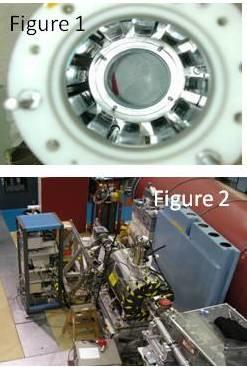Fundamental Physics: Precision Measurement of the Branching Ratio and Energy Spectrum of Radiative Neutron Decay
Summary
Neutron beta-decay is typically considered as a three-body process, but it is always accompanied by inner-bremsstrahlung soft photons, n → e− + p + νe + γ. This branch of the decay that includes the photon permits test of theoretical calculations and corrections. The experiment was completed at the NIST Center for Neutron Research (NCNR) on the NG-6 beamline operated by the Physical Measurement Laboratory.
Description

Figure 1: Photon detection is done by twelve BGO crystals viewed by avalanche photodiodes forming an annular ring around the neutron beam. Figure 2: Photograph of the apparatus assembled on the NG-6 beam line. The superconducting solenoid is in the center and the beam line is seen entering near the bottom.
While inner-bremsstrahlung has been measured in nuclear beta decay and electron capture decays, it has only recently been observed in free neutron beta decay. In 2006, we reported the first observation of this radiative decay mode in the journal Nature. The experiment was completed at the NG-6 fundamental physics end station at the NCNR. Since that time, we upgraded the apparatus to enable us to make a precision measurement of the branching ratio and energy spectrum of the decay photons. The experiment operated by detecting an electron in prompt coincidence with a photon followed by a delayed proton. The requirement that there be a coincidence of these three particles provided a powerful suppression of background events. This was critical because the very low rate of these events was insufficient to make it measurable above the large rate of random coincidences.
A beam of cold neutrons passed through the bore of a superconducting solenoid. Decay electrons and protons were guided out of the beam by the magnetic field and detected by a silicon detector. The primary improvement was increasing the solid angle of photon detection by constructing a 12-element annular BGO detector that surrounded the decay region of the cold neutron beam (Figure 1). The new detector was a significant upgrade to the apparatus (Figure 2), and we completed the data acquisition in November of 2009. The photon detector performed very well as did a second detector consisting of bare photodiodes. This detector allowed us to lower the energy detection threshold to about 500 eV, significantly lower than the 15 keV from the first run. In 2012 we published a paper on operation of the detector. In addition, papers were published on anomalous behavior of avalanche photodiodes in high magnetic fields and at low temperatures and on the response of large area avalanche photodiodes to low energy x-rays.
In this second run of the experiment, we measured the radiative decay branching ratio in the energy range of 14 keV to 782 keV with a total uncertainty of 5 % (12-element bismuth germanate detector) and in the energy range from 0.4 keV to 14 keV with a total uncertainty of 11 % (bare photodiode detector). In both cases the total uncertainty was primarily from systematics, which required substantial analysis. These results were published in 2016 in Physical Review Letters and represent the first precision test of the shape of the photon energy spectrum from neutron radiative decay and a substantially improved determination of the branching ratio over a broad range of photon energies.

